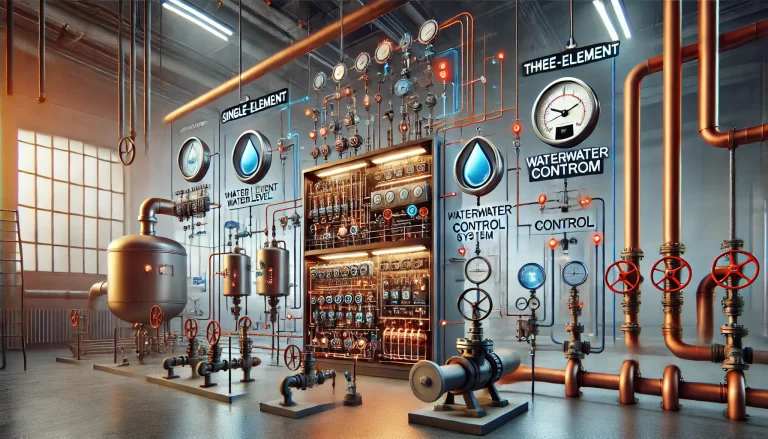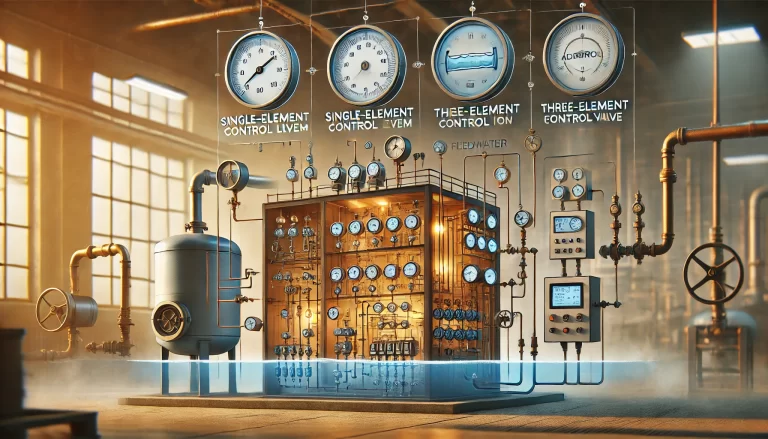Introduction
Water level control is a critical process in industrial applications, particularly in boiler systems, where maintaining an optimal water level is essential for efficiency and safety. Among the various control strategies, Single-Element Control and Three-Element Control are two commonly used techniques. This article provides a detailed comparison of these control methods, their working principles, advantages, disadvantages, and applications.
1. Single-Element Control
Working Principle
Single-Element Control, also known as Single-Loop Control, is a basic water level regulation method that relies on a single input—the measured water level in the boiler’s steam drum. The control process follows these steps:
A level sensor (typically a differential pressure transmitter) measures the boiler water level.
If the water level drops below the setpoint, the controller increases the feedwater flow rate to replenish it.
If the water level rises above the setpoint, the controller reduces the feedwater flow rate.
This type of control functions in a feedback loop, where the system reacts based on real-time water level measurements.
Advantages of Single-Element Control
Simple and cost-effective: Easy to implement and requires minimal instrumentation.
Sufficient for small boilers: Suitable for low-capacity boilers or systems with minimal load fluctuations.
Straightforward tuning: Easier to configure and maintain.
Disadvantages of Single-Element Control
Affected by load changes: During rapid load fluctuations, the water level reading may be misleading due to shrink and swell effects in the steam drum.
Delayed response: The system reacts only after the water level changes, potentially causing instability.
Less accurate control: Inadequate for large boilers where steam and water demand vary dynamically.
Best Applications
Small industrial boilers with constant steam demand.
Simple heating applications with minimal process variation.

2. Three-Element Control
Working Principle
Three-Element Control is a more advanced and precise method, utilizing three process variables:
Water Level (First Element) – Measured using a level sensor in the steam drum.
Steam Flow Rate (Second Element) – Monitored with a steam flow meter to anticipate water level changes.
Feedwater Flow Rate (Third Element) – Measured to ensure the feedwater supply matches steam consumption.
The control mechanism operates as follows:
If the steam flow rate increases, the controller predicts a drop in water level and proactively increases the feedwater flow.
If the steam flow decreases, the controller reduces the feedwater supply to prevent overfilling.
The system continuously balances water inflow with steam outflow, ensuring stable operation.
Advantages of Three-Element Control
Minimizes shrink and swell effects: By considering steam flow, the system reacts to load changes before the actual water level is affected.
Faster response time: Since the controller anticipates changes, the water level remains more stable.
Ideal for high-capacity boilers: Capable of handling large fluctuations in steam demand.
Increased efficiency: Reduces feedwater wastage and prevents unnecessary boiler shutdowns.
Disadvantages of Three-Element Control
Complex and expensive: Requires multiple sensors, transmitters, and an advanced control algorithm.
More challenging to configure: Requires precise calibration and tuning for optimal performance.
Higher maintenance requirements: Additional instrumentation increases system complexity and maintenance needs.
Best Applications
Large power plants and high-capacity industrial boilers.
Steam-generating processes with frequent load changes, such as refineries and chemical plants.
Systems requiring precise water level control to maximize efficiency and prevent downtime.
3. Comparison of Single-Element and Three-Element Control
| Feature | Single-Element Control | Three-Element Control |
|---|---|---|
| Control Inputs | Water Level Only | Water Level, Steam Flow, and Feedwater Flow |
| Complexity | Simple | Complex |
| Cost | Low | High |
| Accuracy | Moderate | High |
| Response to Load Changes | Slow and Reactive | Fast and Predictive |
| Application | Small, steady-load boilers | Large boilers with varying loads |
4. Choosing the Right Control Strategy
When to Use Single-Element Control?
If your system is small and operates under stable conditions.
If budget constraints make complex instrumentation impractical.
If a basic level-based control is sufficient for the process.
When to Use Three-Element Control?
If the boiler operates in a high-demand, fluctuating load environment.
If precision and efficiency are critical to the process.
If large amounts of steam are generated, requiring tight water level control.

Conclusion
Water level control is vital for safe and efficient boiler operation. Single-Element Control provides a simple, low-cost solution for steady-load applications, whereas Three-Element Control ensures accurate and stable regulation in high-demand environments. Choosing the right strategy depends on the size of the system, the variability of the load, and the required precision. Advanced control methods such as Three-Element Control are increasingly adopted in modern industries due to their superior efficiency and reliability.
